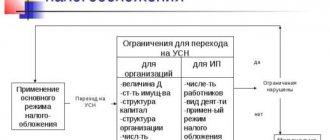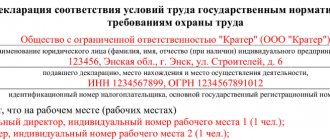New in UTII in 2022
The special UTII regime is very popular among small businesses, as it allows you to significantly reduce reporting and pay a limited amount of tax. Conveniently, the UTII size is:
- does not depend on actual income received;
- may not change if the business parameters actually change (except for the physical indicators involved in the calculation).
In addition, UTII can be reduced by insurance premiums paid for employees, and individual entrepreneurs deduct from it pension and medical accruals paid for themselves (Article 346.32 of the Tax Code of the Russian Federation).
In 2022, UTII is not valid in all regions. And in 2022, it is planned to completely abolish UTII throughout the Russian Federation (Federal Law No. 97-FZ dated June 29, 2012).
REFERENCE
Considering the blow the canceled UTII could cause to small businesses, in 2022 a bill was introduced to the State Duma to maintain this tax regime for another 3 years - until 2024. As of March 2022, this bill is under consideration. We will monitor his fate and will definitely write what decision was made by legislators.
In fact, the gradual abolition of UTII has already begun. Thus, amendments were made to the definition of “retail trade” for the purpose of applying UTII (Federal Law dated September 29, 2019 No. 325-FZ). Such retail does not include trade in goods that are subject to mandatory labeling. This means that it is unacceptable to use UTII when trading them. The law includes medicines, shoes and products made from natural fur as such goods.
In this case, only a simplified taxation system can serve as an adequate alternative to UTII for small businesses. One could consider the option of PSN, but it is used only by individual entrepreneurs, so it is not suitable for organizations. In addition, trade in labeled goods is also excluded from the PSN.
In connection with the proposed abolition of UTII from 2022, the transition from the simplified tax system to UTII does not seem relevant. We'll talk about the reverse transition below.
What you need to know about UTII
This special regime is beneficial for many organizations, but it will only apply until 2022.
For UTII, it doesn’t matter how much you earn - there is no maximum limit. But imputed income is important, which is calculated according to the rules prescribed in Art. 346.29 of the Tax Code of the Russian Federation: calculated as the product of the basic profitability for a certain type of business activity, calculated for the tax period, and the value of the physical indicator characterizing this type of activity. This is what needs to be paid.
Payers of UTII can reduce the amount of tax calculated for the tax period by the amounts of payments and benefits that were paid in favor of employees employed in those areas of activity for which a single tax is paid. In this case, the amount of reduction cannot exceed 50% of the calculated tax.
An individual entrepreneur without employees has the right to reduce the amount of UTII by the amount of insurance contributions paid (for himself) in a fixed amount to compulsory health insurance and compulsory medical insurance without applying the 50% limit.
Changes to the simplified tax system in 2022
With the simplified version, the picture is more rosy than with UTII. Back in 2022, a bill was submitted for consideration that provides for some preferences for simplified tax payers: it stipulates a transition period in case of violation of the simplified tax system limits.
REFERENCE
Previously, if the limits on the cost of fixed assets and the average number of employees were exceeded, the taxpayer lost the right to use the simplified tax system. It is now proposed that if are slightly exceeded, the right to the simplified tax system will not be lost, but tax rates will be increased. If the bill is passed, the changes will come into force on 01/01/2021. We will also monitor this bill and report all the latest news.
In addition, the option of exempting taxpayers from submitting reports to the simplified tax system “income” when they use online cash registers is being considered.
The simplified tax system tax regime can be applied to all activities of the payer, subject to compliance with certain limits in relation to (Article 346.12 of the Tax Code of the Russian Federation):
- types of activities;
- number of employees;
- cost of fixed assets;
- composition of founders.
But only certain types of taxpayer activities can be transferred to UTII (Article 346.26 of the Tax Code of the Russian Federation). Therefore, combining these two tax regimes is acceptable.
Below in the article we will look at the features of combining UTII and simplified tax system.
When should the application of UTII be completed if the goods include those that are subject to mandatory labeling?
As already mentioned, in 2022 it is prohibited to trade marked goods and apply UTII. It is important to indicate the dates from which this requirement applies:
- fur products – termination of UTII from January 1, 2020 ;
- medicines and footwear – termination of UTII from July 1, 2020 .
As you know, you can switch to the simplified tax system only from the beginning of the calendar year (Article 346.13 of the Tax Code of the Russian Federation). But how does this condition work during the transition from UTII to the simplified tax system with the participation of goods that fall under the label? What about the combination of simplified taxation system and UTII in trade, both retail and non-retail? We will answer these questions further.
If you sell labeled goods: how to switch to the simplified tax system
Unfortunately, laws are often written in such a way that they are subject to multiple interpretations. This is what happened with the transition from UTII to a different taxation system for the sale of labeled goods. The turmoil was caused by clause 2.3 of Art. 346.26 of the Tax Code of the Russian Federation, which states that during a sale that is not related to retail trade, the UTII tax breaks from the special regime and switches to OSNO.
But what if the said taxpayer submitted a notice of application of the simplified tax system and essentially combined the taxes of the simplified tax system and UTII? Having lost the right to UTII, he switches to OSNO and receives a combination of simplified taxation system and OSNO? This is impossible . Hence the conclusion: it was necessary to submit a notice of application of the simplified tax system before December 31, 2019 (if this was not done earlier) and combine the simplified tax system and UTII. Then, after losing the right to UTII, the taxpayer switches to the simplified tax system.
Is a businessman selling labeled goods doomed to pay taxes under the OSNO if he did not submit a notification about the application of the simplified tax system on time, that is, before December 31, 2019? No. The long-awaited letter of the Federal Tax Service dated January 21, 2020 No. SD-4-3/726, agreed upon with the Ministry of Finance of the Russian Federation, was issued. It states that those who have ceased to be UTII payers can switch to the simplified tax system from the beginning of the month when the right to use UTII was lost (clause 3 of Article 346.12 of the Tax Code of the Russian Federation). To do this, within 30 days you must submit a notice of transition to the simplified tax system from the date of termination of the obligation to pay UTII.
Thus, when trading fur, the transition to the simplified tax system should have started in 2022. When selling medicines and shoes, you can submit a notification about the transition to the simplified tax system until July 31, 2022. This is provided that the taxpayer does not conduct any other types of activities on UTII.
Nuances of determining income
When determining the proportional value of income received on the simplified tax system or when applying UTII, it should be borne in mind that some income cannot be shared. Thus, only under a simplified taxation system (but not when operating on UTII), income may include:
- interest on bank and other deposits (letter of the Ministry of Finance of Russia dated February 19, 2009 No. 03-11-06/3/36);
- sale of fixed assets (letter of the Ministry of Finance of Russia dated December 10, 2010 No. 03-11-11/319).
The procedure for selling fixed assets using the simplified tax system is described in detail in the article “The procedure for selling fixed assets under the simplified tax system “income”” .
At the same time, only supplier discounts can be added to income on UTII (letter of the Ministry of Finance of Russia dated June 16, 2010 No. 03-11-06/3/22).
Within the framework of the simplified tax system, all income calculated using the cash method is taken into account by type of economic activity in this special regime (clause 1 of article 346.17 of the Tax Code of the Russian Federation). You should also take into account what types of business activities can be carried out using tax on imputed income (clause 2 of Article 346.26 of the Tax Code of the Russian Federation).
Explanations on the procedure for proportional distribution of revenue of a taxpayer combining the simplified tax system and UTII are contained in the letter of the Ministry of Finance of Russia dated November 20, 2007 No. 03-11-04/2/279.
Features of accounting for expenses when changing the taxation regime for labeled goods
Money spent on the purchase of goods under the simplified tax system is taken into account when calculating the tax base using the cash method with the following features (clause 2 of article 346.17 of the Tax Code of the Russian Federation):
- The goods must be registered.
- It was paid for.
- The goods are sold to the buyer.
When changing the taxation regime from UTII to the simplified tax system “income minus expenses,” it was not allowed to take into account expenses for goods that were recorded and paid for under UTII after the transition to the simplified tax system. This placed traders of labeled goods in even more unfavorable conditions: income from the sale of goods is taxed, but its cost can no longer be accepted as expenses.
To soften the transition from UTII to the simplified tax system, a bill was submitted for consideration that would allow expenses to be taken into account in this case. Will they accept him or not? Let's follow the news.
Is it possible to combine the simplified tax system and UTII when trading marked and unmarked goods?
This is the next pressing question that worries traders. Several letters were issued in response. This is the already mentioned letter of the Federal Tax Service dated January 21, 2020 No. SD-4-3/726, as well as letters of the Ministry of Finance dated November 13, 2019 No. 03-11-11/87500, dated January 15, 2020 No. 03-11-11/1265.
They indicate that it is permissible to combine activities for the sale of goods, which is retail trade, which is subject to UTII, and activities for the sale of goods, not related to retail trade, which is taxed under the simplified tax system.
What to reflect in accounting policies
Additional subaccounts are introduced into the chart of accounts in order to attribute profits and expenses from both types of activities, which are divided according to the method of taxation.
The section “Income subject to UTII” includes profit from the sale of goods, work, services and other income from the activities that you conduct on imputation. To the section “Income taxed by the simplified tax system” - profit from the activities that you conduct using the simplified tax system. Other income may include:
- surpluses found during the audit;
- penalties received from debtors;
- cash incentives from the counterparty.
Accounting procedure for combining simplified taxation system and UTII
We have dealt with the innovations regarding the impossibility of using UTII when trading labeled goods and the possibility of combining UTII and the simplified tax system. Now let's look at the general issues of combining these tax regimes.
UTII is paid for certain types of activities that the taxpayer has transferred to this taxation system. For all other types of activities, he applies the simplified tax system (subject to timely submission of notification).
With UTII, the amount of income actually received is not important And to calculate tax under the simplified tax system, it is necessary to rely on the amount of income received or the amount of income and expenses - depending on which object of taxation is selected.
How to correctly distribute and calculate expenses and income if UTII and simplified tax system are applied simultaneously? In this case, separate accounting of income and expenses is maintained (clause 8 of Article 346.18 of the Tax Code of the Russian Federation, clause 7 of Article 346.26 of the Tax Code of the Russian Federation).
How to separately calculate income
As a rule, there are no difficulties with separate accounting of income. Income from UTII activities is not included .
The tax base under the simplified tax system includes income from simplified taxation system activities, which are determined according to the rules of the simplified tax system (Article 346.15 of the Tax Code of the Russian Federation, Article 346.17 of the Tax Code of the Russian Federation).
It is enough to keep different income registers. For example, separate accounting of income in 1C with UTII and simplified tax system can be organized by entering additional subaccounts for types of activities on UTII and simplified tax system into the chart of accounts.
Method of separate calculation of expenses
The division of expenses is relevant if, under the simplified tax system, an object is selected - the difference between income and expenses. If under the simplified tax system only income is subject to taxation, then the issue becomes exclusively the distribution of insurance premiums. We'll talk about how to deal with them below.
When calculating the taxable base under the simplified tax system, it is necessary to take only those costs that are incurred in relation to the activities transferred to the simplified tax system. Expenses associated with UTII are similar to income - we discard them.
Difficulties may arise if there are expenses that relate to both tax systems and cannot be distributed directly. These could be, for example, rent of common premises, salaries of administrative staff and contributions from them, and so on.
In this case, expenses are distributed in proportion to the shares of income in the total amount of income (clause 8 of Article 346.18 of the Tax Code of the Russian Federation).
How exactly the proportion should be calculated is not established by law. The taxpayer can develop the calculation algorithm himself. It needs to be enshrined in academic policy. Explanatory letters suggest making calculations based on the results of each month, which seems rational and reflects the real state of affairs (letter of the Ministry of Finance dated May 23, 2012 No. 03-11-06/3/35).
Separate accounting of insurance premiums
When combining the simplified tax system and UTII, accounting for insurance premiums is the most pressing issue, since they can reduce both the UTII tax and the simplified tax system tax for the object of taxation “income”. In addition, this reduction can occur in different proportions.
Let's consider various initial cases and possible options for accounting for insurance premiums:
Rules for organizing separate accounting
The most important rule for organizing separate accounting for a taxpayer is the approval in the accounting policy of the very procedure for maintaining such separated accounting, as well as the choice of formulas for the distribution of income and costs according to different regimes, if such distribution is necessary. Consolidating the principles of maintaining separate accounting in the accounting policy for legal entities is mandatory, but for individual entrepreneurs, who are not required by law to maintain accounting, it is highly desirable (so that the applied distribution principles can be justified to the Federal Tax Service).
It is also necessary to consolidate the rules of separate accounting because the tax legislation does not clearly stipulate:
- how exactly separate accounting should be kept;
- what methods should be used when determining costs;
- what registers need to be kept;
- what should be the frequency of distribution of costs and insurance payments;
- some other points.
That is, the organization of separate accounting allows for the existence of different options. The presence of a document with the accepted methods and procedures enshrined in it serves as a justification for the legality of the applied methods of separate accounting.
Read about the main provisions reflected in the accounting policy for the simplified tax system in this article.
Reporting when combining UTII and simplified tax system
If you conduct business both under the simplified tax system and under UTII, then no questions arise - declarations must be submitted under both special taxation regimes.
Let's consider situations where in practice only one taxation system is used:
| SITUATION | SOLUTION |
| Activities are carried out only on UTII, but a notification about the application of the simplified tax system was submitted | The issue of submitting a declaration under the simplified tax system in this case is definitely not resolved, but it is still safer to submit a zero tax once a year. Moreover, it does not require much time or labor. You can also send it by mail with acknowledgment of delivery. |
| Activities are carried out only according to the simplified tax system | In this case, there are no options: you will have to not only submit a UTII return, but also pay this tax. UTII does not depend on actual income received, so it must be paid even if there is no activity. For the same reasons, zeros for UTII are not provided. If you do not carry out activities on UTII, in order to avoid unnecessary payments, it is better to deregister as a UTII payer. |







